North Carolina
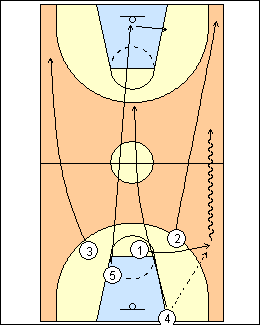 | 1 Roy Williams 2005, 2008 There's a better opportunity to get a shot before the defence is set. If there are two or fewer defenders back, shoot with two or fewer passes (primary break). Run the secondary break with more than two defenders, flatten the defence, swing it from side to side, try to get it inside, look for a lob, then go free-lance. Run after a miss or make, get the ball out of the net quickly. North Carolina has three rules against a set defence - 3 passes unless it's a layup, change sides of the floor, give the defence a chance to make a mistake. 4 and 5 are interchangeable, as are 1, 2 and 3. If two players run the same sideline, the second player crosses to the other side. The point guard gets his butt to the ballside sideline, the first big goes to the front of the rim then posts up low ballside. The trailer stops at the top. |
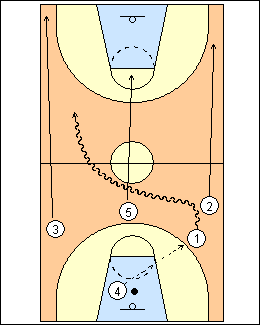 | 2 As soon as an outlet pass is made on a miss, 1 takes one dribble, if he can't pitch ahead he crosses over to the other side, X5 has to get from one side of 5 to the other side. If one big is a good shooter and the other a great low-post guy, they run, a) but the shooter can slow and the other big runs right past him, they go to their comfort zones, or b) the shooter runs and posts, then the other big comes down and screens for him to switch spots. |
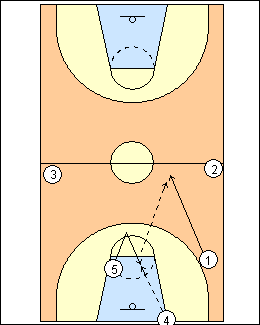 | 3 4 and 5 rebound, the rebounder will outlet or inbound, using an overhead (or baseball) pass, the other big runs the floor. On a make, get the ball out of the net quickly, run out of bounds with two hands on the ball, don't go out the same side all the time. Get the ball out and in so fast they can't press you. On a miss, the rebounder can take an escape dribble to get out of traffic (if he takes a second dribble, he's taking it, everyone else releases as hard as they can). Against pressure, the rebounder can see the defence. The non-rebounding big is an emergency outlet. Make or miss, he runs up the middle of the floor, at the top of the arc he turns to see if 1 is denied, if so he comes towards the ball. On a pass to the emergency outlet, 1 sprints upcourt (shown). If 1 gets out to the sideline and doesn't get the ball, he runs back catching the ball on the run (Bruce Pearl - circle back move). On a defensive rebound, a hand-off to the point guard is an option, but that doesn't get the ball upcourt quickly. 2005 - they want 1 to catch the inbounds pass on the run if possible, if he feels pressure he gets to the outlet spot with his tail to the sideline. |
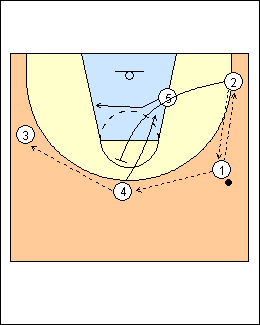 | Secondary Break Regular 2 is in the ballside corner, 3 is on the weakside wing. 1 passes to 4 if 2 is denied, most of the time get it to 2. On a pass to 3, 5 cuts to the other low post, 2 sprints to touch the block then backscreen for 4. 3 looks for a lob pass to 4 for a dunk. 2, 1, 4 and 3 all try to throw inside to 5, he is always the first option (you may not want 4 making the high-low pass). If he works his butt off, the defence won't pressure on the perimeter because he will kill them inside. 2 can skip pass to 4 or 3 if ball reversal is denied. If no one is in front of 1, he can dribble to the corner, 2 fills behind. On a pass into the low post from 3, they like 4 to dive to the rim or weakside, the passer can slash to the basket if he is a rebounder/athlete, or screen for the player at the top. |
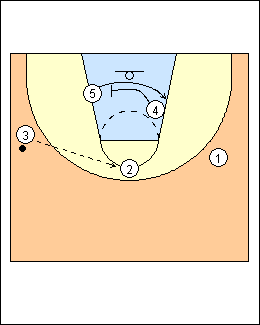 | 5 2 turns to the ball. On a pass to 2, 4 screens for 5, who always goes low. 2 looks to hit 4 or 5 inside, a pass to 1 or 3 starts a free-lance attack (or 3-out 2-in motion). They have made three passes with no layup, and changed sides of the floor. Option - you can keep 5 and 4 on their sides after the backscreen by 2. The only differences against a zone defence are that 2 will backscreen a zone defender in the middle, or come to the middle if there is no defender there, and he may need to come further out top to get a pass from 3. |
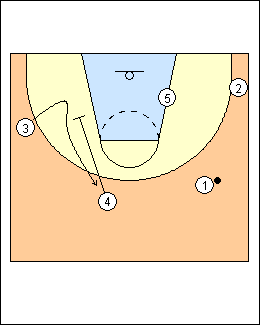 | 6 The defence can't take away the secondary break. North Carolina has many options (15 in total), including against denials. B-3 If 4 is denied, on his own he screens for 3 (a read, not a call), he is still looking to get the ball. |
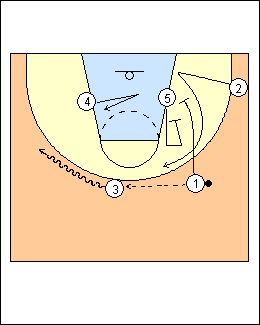 | 7 1 passes to 3 who dribbles back to the other side for a two-man game, 4 fakes a screen for 5 then spins back to the ball. 1 and 5 stagger screen for 2, 1 goes first. 5 walks up the lane so his defender can't help on 4, and defenders are less likely to switch with 5 as the top guy in the screen. Any time they have a two-man game on one side they have a stagger on the other side, a big guy is the second screener. |
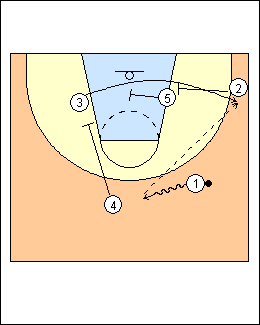 | 8 B-3 Counter mensbasketballhoopscoop.blogspot.com A call. 3 rejects 4's screen and runs the baseline using 5 and 2, who will cross-screen for 5 on the pass to 3. See Fast breaks - Florida 2005. |
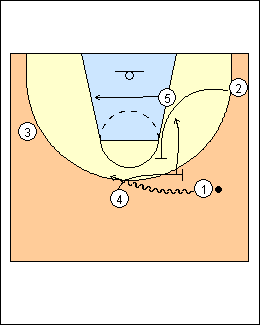 | 9 Dribble A read. 4 is denied but 1 doesn't want him to run B-3, so 1 looks at 4 and starts dribbling at him (or points to the ground), 4 ballscreens, 5 gets out to the other side, 2 backscreens for a lob pass to 4. |
 | 10 On a pass to 2, 1 and 5 stagger screen for 3. |
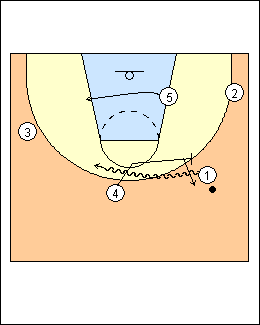 | 11 Dribble spin-out 4 ballscreens and spins out behind the arc for a pass from 1, 2 does not backscreen (shown). Dribble-hold 4 spins out for a pass, 2 goes in to post at the block (4 and 2 switch spots). |
 | 12 Backdoor double This is a call. 3 is denied when 4 has the ball, he starts inside the arc, goes outside, throws up his hand and goes backdoor. 1 and 5 stagger screen for 2, 4 dribbles over if there is no pass on the backdoor. |
 | Dive Another read. 1 reverse dribbles, 4 takes a step out and goes backdoor, 3 comes up for a pass, but they want him to get it on the side. |
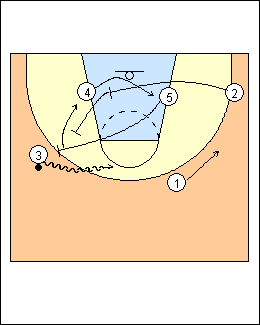 | 14 5 ballscreens, 1 spaces, 2 screens for 4 (who goes low) then 2 screens for 5, getting him to the board. |
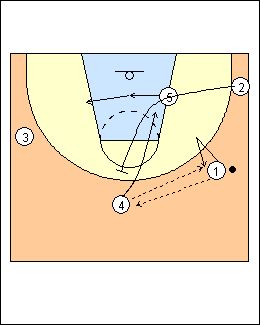 | 15 Kickback Another read. 4 decides to kick it back to 1 (who always steps inside the arc and v-cuts back out when he passes to 4). 5 gets out, 2 backscreens for 4 who goes strongside. FIBA Assist issue 15 - 4 passes back to 1 when 3 is overplayed. |
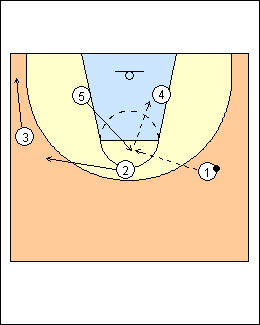 | 16 2 clears weakside, 5 comes up for a shot or high-low pass to 4. FIBA Assist - 2 clears to the weakside corner, then 3 downscreens for him. |
 | 17 Screen for the screener A call. It's like the regular secondary break except that after backscreening for 4, 2 gets a screen from 5. |
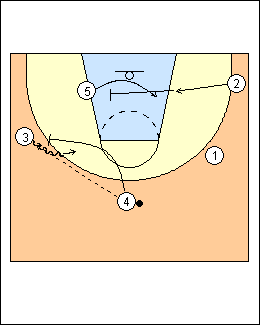 | 18 Sweep A read. 4 hits 3 and follows to ballscreen. As usual, 2 goes to the weakside block on the pass to 3 and 5 goes to the ballside block, then 2 screens for 5 when 4 ballscreens. |
This page was made with Basketball playbook from Jes-Soft